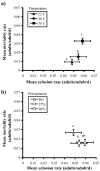Precipitation and temperature effects on populations of Aedes albopictus (Diptera: Culicidae): implications for range expansion
- PMID: 11580037
- PMCID: PMC2579929
- DOI: 10.1603/0022-2585-38.5.646
Precipitation and temperature effects on populations of Aedes albopictus (Diptera: Culicidae): implications for range expansion
Abstract
We investigated how temperature and precipitation regime encountered over the life cycle of Aedes albopictus (Skuse) affects populations. Caged populations of A. albopictus were maintained at 22, 26, and 30 degrees C. Cages were equipped with containers that served as sites for oviposition and larval development. All cages were assigned to one of three simulated precipitation regimes: (1) low fluctuation regime - water within the containers was allowed to evaporate to 90% of its maximum before being refilled, (2) high fluctuation regime - water was allowed to evaporate to 25% of its maximum before being refilled, and (3) drying regime - water was allowed to evaporate to complete container dryness before being refilled. Greater temperature and the absence of drying resulted in greater production of adults. Greater temperature in combination with drying were detrimental to adult production. These precipitation effects on adult production were absent at 22 degrees C. Greater temperatures and drying treatments yielded higher and lower eclosion rates, respectively and, both yielded greater mortality. Development time and size of adults decreased with increased temperatures, and drying produced larger adults. Greater temperatures resulted in greater egg mortality. These results suggest that populations occurring in warmer regions are likely to produce more adults as long as containers do not dry completely. Populations in cooler regions are likely to produce fewer adults with the variability of precipitation contributing less to variation in adult production. Predicted climate change in North America is likely to extend the northern distribution of A. albopictus and to limit further its establishment in arid regions.
Figures







References
-
- Aspbury AS, Juliano SA. Negative effects of habitat drying and prior exploitation on the detritus resource in an ephemeral aquatic habitat. Oecologia (Berl) 1998;115:137–148. - PubMed
-
- Bradshaw WE, Holzapfel CM. Seasonal development of tree-hole mosquitoes (Diptera: Culicidae) and chaoborids in relation to weather and predation. J Med Entomol. 1984;21:366–378.
-
- Bradshaw WE, Holzapfel CM. Drought and the organization of tree-hole mosquito communities. Oecologia. 1988;74:507–514. - PubMed
Publication types
MeSH terms
Substances
Grants and funding
LinkOut - more resources
Full Text Sources

